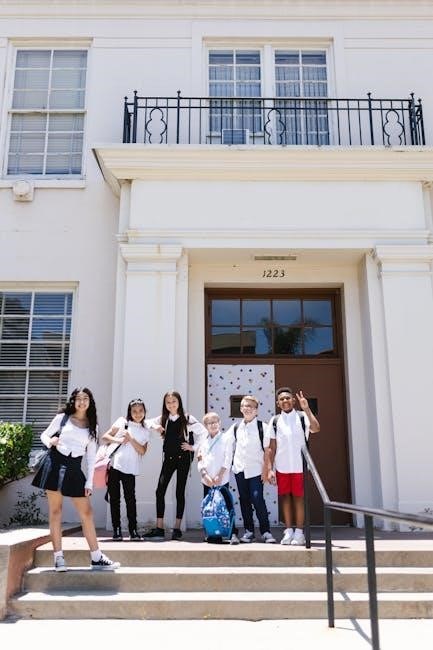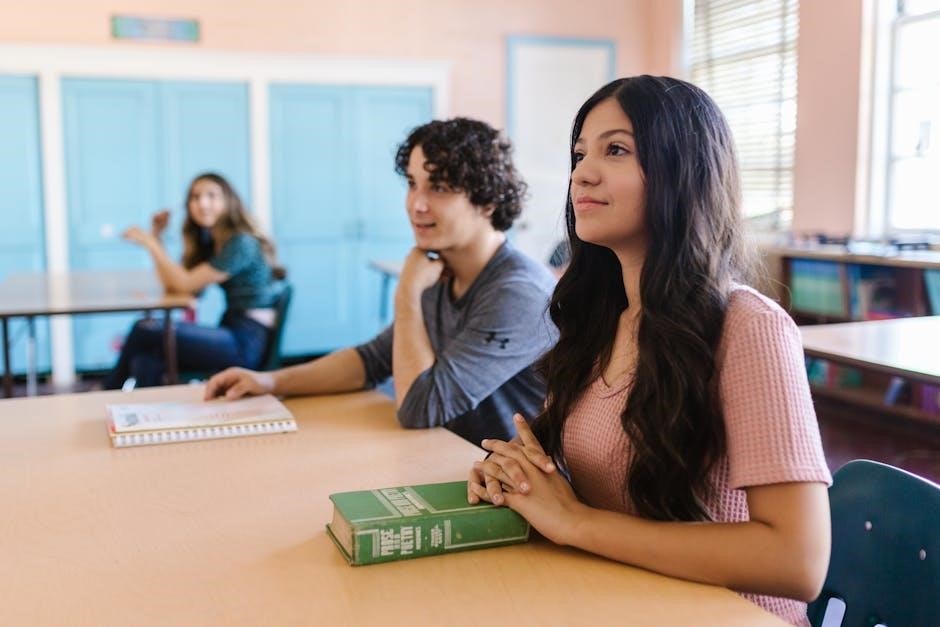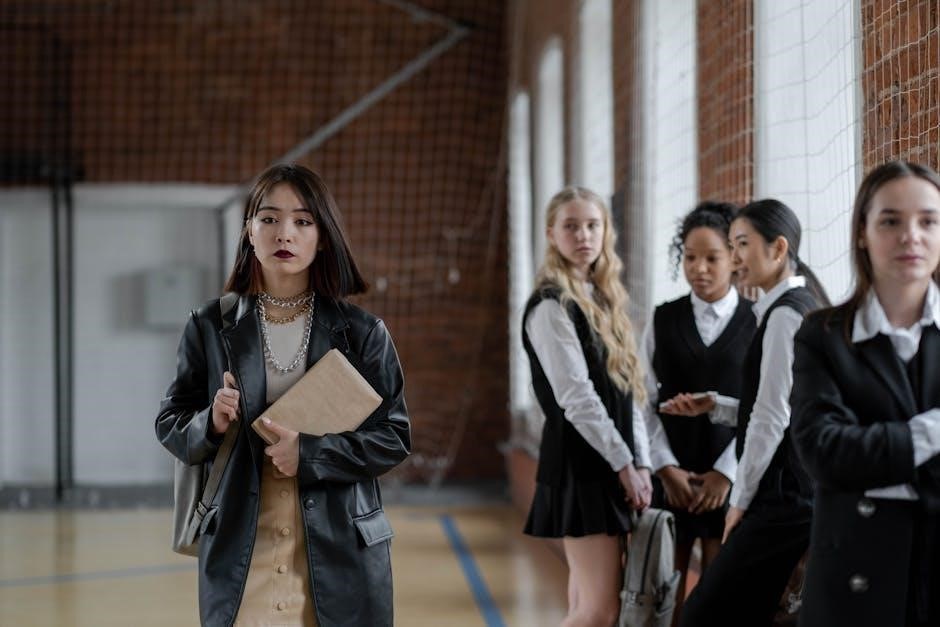
Icebreakers for high school students are engaging activities designed to foster connections, reduce anxiety, and encourage participation, creating a welcoming environment for social interaction and learning․
What Are Icebreakers?
Icebreakers are interactive activities or exercises designed to help individuals feel comfortable and connected in new social or learning environments․ They are often used at the beginning of group sessions, such as classes, workshops, or team-building events, to ease tension and encourage communication․ Icebreakers typically involve sharing personal information, completing group challenges, or engaging in light-hearted games․ These activities are simple, low-stakes, and require minimal preparation, making them accessible for all participants․ Examples include “Two Truths and a Lie,” “The Name Game,” and “The Scar Game․” By fostering active participation and shared experiences, icebreakers create a positive atmosphere for collaboration and friendship, especially among high school students navigating new social dynamics․
Importance of Icebreakers in High School
Icebreakers play a vital role in high school settings by fostering a welcoming and inclusive environment․ They help students overcome initial hesitation and anxiety, allowing them to feel more comfortable interacting with peers․ These activities are particularly beneficial during the beginning of the school year or when introducing new groups․ Icebreakers encourage students to share their thoughts, interests, and experiences, which helps build camaraderie and mutual understanding․ By promoting active participation, they also enhance engagement in classroom discussions and collaborative projects․ Additionally, icebreakers support social-emotional learning by teaching students essential communication and teamwork skills․ They create a positive foundation for academic and personal growth, making them an invaluable tool for educators and students alike․

Benefits of Icebreakers

Icebreakers promote social comfort, encourage participation, and foster meaningful connections among students, helping to ease transitions and create a positive environment for learning and interaction․
Reducing Anxiety and Tension
Icebreakers play a crucial role in alleviating anxiety and tension among high school students, especially in new or unfamiliar settings․ By engaging students in lighthearted and interactive activities, icebreakers help ease social fears and create a comfortable environment for interaction․ These activities often involve sharing simple information or participating in low-stakes games, which encourage students to open up without feeling pressured․ This process helps students feel more at ease, reducing the initial hesitation and nervousness that can hinder social connections․ As a result, icebreakers foster a sense of belonging and camaraderie, making it easier for students to express themselves and participate actively in group settings․ This supportive atmosphere is essential for building confidence and promoting positive social interactions․
Fostering Connections and Friendships
Icebreakers are effective tools for fostering meaningful connections and friendships among high school students․ By encouraging collaboration and shared experiences, these activities help students bond over common interests or unique traits․ Interactive games and group exercises allow students to learn about one another in a relaxed and engaging manner, breaking down social barriers․ Sharing personal anecdotes or participating in team-building challenges creates a sense of camaraderie, helping students feel connected and valued․ This mutual understanding lays the foundation for lasting friendships and a supportive learning environment․ Icebreakers not only promote social interaction but also empower students to step out of their comfort zones, fostering a sense of community and shared purpose․

Types of Icebreakers
Icebreakers include interactive games, group activities, and sharing exercises, designed to engage students, promote teamwork, and encourage meaningful interactions in a fun and inclusive setting․
Interactive Games
Interactive games are dynamic and engaging icebreakers that encourage participation and teamwork among high school students․ These activities are designed to be fun and inclusive, helping students break out of their shells․ Games like “Two Truths and a Lie” and “The Name Game” are popular choices, as they foster conversation and laughter․ For example, in “Two Truths and a Lie,” students share two true statements and one false statement about themselves, while others guess which one is the lie․ This activity not only promotes interaction but also helps students learn interesting facts about each other․ Similarly, “The Name Game” involves pairing names with unique traits, making it easier for students to remember each other․ These games create a relaxed environment, reducing anxiety and encouraging friendships․ They are ideal for the start of a new school year or any group setting where students need to connect․
Group Activities
Group activities are excellent icebreakers for high school students, fostering teamwork and collaboration․ These exercises encourage students to work together toward a common goal, breaking down barriers and building connections․ Examples include group scavenger hunts, where students collaborate to find or complete tasks, and human knots, where participants must untangle themselves without letting go of each other’s hands․ Another popular activity is the “Person Scavenger Hunt Bingo,” where students interact to find peers who fit specific traits or characteristics․ These activities promote creativity, problem-solving, and mutual respect․ By engaging in shared experiences, students develop stronger bonds and a sense of belonging․ Group activities are particularly effective in large settings, such as classrooms or retreats, and help create a supportive and inclusive environment for everyone involved․
Sharing Exercises
Sharing exercises are powerful icebreakers that encourage students to open up and connect on a personal level․ These activities often involve students sharing thoughts, experiences, or interests in a structured format․ For example, “Two Truths and a Lie” prompts students to share two true statements and one false statement about themselves, sparking curiosity and conversation․ Similarly, “The Name Game” combines introductions with fun facts, helping students remember names and learn about their peers․ Sharing exercises like “The Scar Game” or “If I Could․․․” foster empathy and creativity, allowing students to express themselves authentically․ These exercises create a supportive environment, helping students feel comfortable and valued while building meaningful connections with one another․
By encouraging vulnerability and active listening, sharing exercises lay the groundwork for stronger relationships and a positive classroom culture․

How to Choose the Right Icebreaker
Selecting the right icebreaker involves considering group size, age, and interests to ensure a comfortable and engaging experience for all students, fostering participation without pressure;
Considering the Group Size
When selecting an icebreaker, group size plays a crucial role in ensuring effectiveness․ For smaller groups, activities like “Ive Got Mail” or “Two Truths and a Lie” encourage personal connections and active participation․ In larger settings, structured games such as “The Name Game” or “Human Knot” are ideal, as they promote engagement without overwhelming individuals․ It’s essential to balance interactivity with manageability, ensuring all participants feel included․ Clear instructions and time limits help maintain focus and prevent chaos․ By tailoring the activity to the group size, educators create an environment where students can comfortably interact, fostering meaningful relationships and setting the tone for collaborative learning․ This approach ensures icebreakers are both enjoyable and productive for all involved․
Aligning with the Group’s Age and Interests
Icebreakers for high school students should align with their age and interests to ensure engagement and relevance․ Activities like the M&M Game or The Scar Game resonate well with teenagers, as they are interactive and easy to understand․ Incorporating elements of pop culture, music, or technology can make icebreakers more appealing․ For example, using trending topics or relatable scenarios encourages participation and fosters connections․ Tailoring icebreakers to the group’s preferences ensures students feel comfortable and willing to engage․ This approach not only enhances the effectiveness of the activity but also creates a positive and inclusive environment for social interaction and learning․ By matching the activity to the group’s interests, educators can ensure a fun and memorable experience that promotes teamwork and camaraderie among high school students․

Popular Icebreaker Activities
Popular icebreakers include Two Truths and a Lie, The Name Game, The Scar Game, and the M&M Game, all designed to engage students and foster connections․
Two Truths and a Lie
Two Truths and a Lie is a popular icebreaker where students share two true statements and one false statement about themselves․ Peers then guess which one is the lie, fostering curiosity and laughter․ This activity encourages students to open up, share personal experiences, and engage with classmates in a fun, relaxed manner․ It helps break down barriers, builds connections, and creates a sense of camaraderie․ The simplicity of this game makes it accessible for all students, regardless of their background or personality․ It’s an excellent way to kickstart conversations and help students feel comfortable in new social settings․ Two Truths and a Lie is widely used in classrooms and group activities to promote teamwork and friendship․
The Name Game
The Name Game is a classic icebreaker that helps students learn and remember each other’s names in a fun and interactive way․ Each participant introduces themselves by sharing their name along with a unique fact, hobby, or trait that starts with the same letter as their name․ For example, “Hi, I’m Alex, and I love astronomy․” This activity not only makes name-recognition easier but also sparks conversations and connections․ The Name Game is simple to organize and works well in classrooms, group settings, or even virtual meetings․ It encourages active listening and helps students feel more comfortable interacting with peers․ This engaging activity is a great way to build camaraderie and set a positive tone for the school year․
The Scar Game
The Scar Game is an engaging icebreaker where students share the story behind a scar they have, helping to foster connections and curiosity․ Each participant explains how they got their scar, making the activity personal and memorable․ This game encourages storytelling and active listening, allowing students to learn unique aspects of their peers’ lives․ It’s simple to execute and works well in both in-person and virtual settings․ The Scar Game helps reduce initial awkwardness and builds rapport among students․ By focusing on personal experiences, it creates a sense of camaraderie and makes students feel more comfortable interacting with one another․ This activity is especially effective for high school students, as it promotes empathy and engagement in a fun and relaxed manner․
M&M Game
The M&M Game is a fun and interactive icebreaker where students sort M&M candies by color and share facts about themselves․ Each color corresponds to a specific question or topic, such as hobbies, favorite subjects, or future goals․ This activity encourages students to open up in a relaxed and engaging way, fostering connections and sparking conversations․ It’s easy to organize and suitable for both small and large groups․ The M&M Game helps break the ice, reduces initial nervousness, and creates a lively atmosphere․ By associating colors with personal stories, it makes the experience memorable and enjoyable for high school students․ This game is a great way to promote interaction and build camaraderie in a classroom or group setting․

Team-Building Icebreakers
Team-building icebreakers foster trust and collaboration through activities like the Human Knot and Blind Trust Walk, encouraging students to work together and communicate effectively․
Human Knot
The Human Knot is a popular team-building icebreaker where students stand in a circle, grab hands with two people not adjacent to them, and work together to untangle themselves without letting go․ This activity promotes effective communication, problem-solving, and trust among participants․ It encourages collaboration and teamwork, helping students bond while resolving the challenge․ The Human Knot is ideal for high school students as it fosters a sense of unity and shared accomplishment․ It’s simple to organize and requires no special equipment, making it a versatile choice for various group sizes․ The activity not only strengthens interpersonal connections but also provides a fun and engaging way to break the ice in a new or familiar setting․
Blind Trust Walk
The Blind Trust Walk is a powerful icebreaker that fosters trust and communication among high school students․ In this activity, one student is blindfolded while another guides them through a designated space using only verbal instructions․ The blindfolded student must rely entirely on their partner’s directions, promoting trust and teamwork․ This exercise helps students build confidence in one another, understand the importance of clear communication, and develop empathy․ It’s an excellent way to break down barriers and create a supportive environment․ The Blind Trust Walk is simple to set up, requiring minimal resources, and can be adapted to suit different group sizes and dynamics․ It’s a memorable experience that strengthens interpersonal connections and encourages students to step out of their comfort zones․

How to Lead an Effective Icebreaker Session
Leading an effective icebreaker session involves creating a comfortable environment, encouraging participation, and guiding activities with clarity․ A positive atmosphere and clear instructions ensure successful interaction and engagement among high school students․
Creating a Comfortable Environment
Creating a comfortable environment for icebreakers involves fostering a positive and inclusive atmosphere where high school students feel safe and supported․ Ensure the space is free from distractions and promotes equality among participants․ Encourage open communication by setting clear expectations and emphasizing respect․ Provide a welcoming setting with appropriate seating and lighting to help students relax․ Icebreakers should be designed to accommodate diverse personalities and comfort levels, allowing shy students to participate without pressure․ By creating a judgment-free zone, you help students feel at ease, which is essential for meaningful interactions and building connections․ A comfortable environment lays the foundation for successful icebreaker activities, ensuring students are engaged and willing to participate actively․
Encouraging Participation
Encouraging participation in icebreakers is crucial for their success․ Start by ensuring all activities are inclusive and accessible to every student, regardless of personality or comfort level․ Use positive reinforcement by praising students for their contributions, which helps build confidence․ Provide clear instructions and examples to guide participants, reducing uncertainty․ Incorporate a mix of individual and group tasks to cater to different preferences․ Offer optional sharing opportunities, allowing students to engage at their own pace․ Avoid forced participation, as it can create discomfort․ Instead, create a supportive atmosphere where students feel motivated to join in voluntarily․ Encouraging participation fosters engagement, collaboration, and a sense of community, making icebreakers more effective and enjoyable for all high school students․

Creative Icebreaker Ideas
Creative icebreakers like Person Scavenger Hunt Bingo and Nonverbal Birthday Lineup engage high school students through interactive and fun activities, fostering connections and collaboration in a unique way;
Person Scavenger Hunt Bingo
Person Scavenger Hunt Bingo is a creative and engaging icebreaker where students create bingo cards with unique traits, hobbies, or interests in each square․ Participants then mingle to find peers who fit each description, getting them to sign the corresponding square․ This activity encourages interaction, helps students discover commonalities, and fosters a sense of community․ It’s ideal for large groups and can be tailored to different ages or interests, making it a versatile tool for high school settings․ The goal is to complete the bingo card by connecting with others, promoting teamwork and conversation in a fun and dynamic way․
- Encourages meaningful interactions and teamwork․
- Helps students identify shared interests and build connections․
- Can be customized to suit the group’s preferences and size․
Nonverbal Birthday Lineup
The Nonverbal Birthday Lineup is a unique icebreaker where students line up silently in order of their birthdays without speaking․ This activity challenges participants to communicate nonverbally, fostering teamwork and creative problem-solving․ It encourages students to think outside the box and rely on gestures, expressions, and collaboration to achieve the goal․ Once the lineup is complete, a class discussion can follow to reveal how students determined the order, adding a reflective and engaging element․ This activity is simple yet effective, requiring no special materials and easily adaptable to any group size․ It’s an excellent way to break the ice, promote collaboration, and create a lighthearted atmosphere in high school settings;
- Encourages nonverbal communication and teamwork․
- Fosters creative problem-solving and collaboration․
- Provides a fun and engaging way to start a session․
Virtual Icebreakers for Online Classes
Virtual icebreakers are interactive activities designed to connect students remotely, fostering engagement and collaboration in online learning environments while reducing anxiety and encouraging participation effectively․
- Examples include Virtual Two Truths and a Lie and Online Human Bingo․
- These activities are easy to organize and require minimal setup․
Virtual Two Truths and a Lie
Virtual Two Truths and a Lie is a popular icebreaker activity that encourages students to share two true statements and one false statement about themselves․ The rest of the group guesses which one is the lie, fostering active listening and critical thinking․ This activity is ideal for online classes because it requires minimal setup and can be conducted via video conferencing or chat platforms․ It helps students feel comfortable speaking in a virtual environment and builds connections by revealing unique personal traits․ The activity is versatile, suitable for small or large groups, and can be adapted to fit various themes or topics․ It’s a fun and engaging way to break the ice and make students feel comfortable interacting online;
Online Human Bingo
Online Human Bingo is a dynamic and interactive icebreaker activity that adapts the classic game for virtual environments․ Students create or are provided with a digital bingo card containing different traits, hobbies, or interests (e․g․, “has traveled to another country” or “speaks more than one language”)․ Participants then engage in video or chat conversations to find peers who fit each description and mark the corresponding squares․ This activity encourages meaningful interactions, fosters connections, and helps students get to know one another in a fun and structured way․ It’s an excellent tool for online classes, as it promotes engagement and collaboration while breaking the ice in a virtual setting․ The game can be easily customized to suit the group’s interests and age, making it a versatile option for high school students․
Final Thoughts on Icebreakers
Icebreakers are a powerful tool for fostering connections, reducing anxiety, and creating a collaborative environment in high school settings․ They encourage participation, help students feel comfortable, and build camaraderie․ By incorporating fun and engaging activities like Two Truths and a Lie or the Name Game, educators can set the tone for a positive and inclusive classroom or group dynamic․ These activities not only ease transitions but also promote meaningful interactions that can last beyond the initial session․ As high school students navigate social and academic challenges, icebreakers provide a foundation for empathy, teamwork, and open communication, making them an invaluable resource for teachers and facilitators․
Encouraging Ongoing Interaction
Icebreakers play a crucial role in fostering ongoing interaction among high school students by creating a foundation of trust and camaraderie․ These activities help students feel more comfortable engaging with one another, which can lead to deeper connections over time․ By encouraging participation and teamwork, icebreakers set the stage for a collaborative and inclusive environment․ Regular use of such activities can motivate students to communicate openly, share ideas, and support each other academically and socially․ This ongoing interaction helps build a sense of community, making students more likely to participate in class and collaborate on projects․ Ultimately, icebreakers are a valuable tool for promoting lasting engagement and fostering a positive school culture․

Additional Resources
Explore websites like SportsEngine and downloadable PDF guides for creative icebreaker ideas, interactive games, and team-building activities tailored for high school students․
Recommended Websites for Icebreaker Ideas
For high school students, websites like SportsEngine and educational platforms offer a variety of icebreaker ideas․ These sites provide detailed guides, printable worksheets, and interactive activities such as “Two Truths and a Lie” and “Human Bingo․” They cater to different group sizes and ages, ensuring relevance for teens․ Many resources are free and easily accessible, making it simple for teachers or organizers to plan engaging sessions․ These websites also include tips for facilitating activities and encouraging participation․ They are ideal for educators, counselors, and youth leaders looking to create a positive and inclusive environment for high school students․ By using these resources, one can easily find activities that align with their group’s needs and interests, fostering connections and collaboration effectively․
PDF Guides and Workbooks
PDF guides and workbooks are excellent resources for planning icebreaker activities tailored to high school students; Many educational websites and platforms offer downloadable PDFs filled with structured exercises, group games, and reflection prompts․ These workbooks often include step-by-step instructions, printable worksheets, and creative ideas to engage students․ They cover a wide range of activities, from simple name games to complex team-building exercises․ PDF guides are particularly useful for educators, as they provide ready-to-use materials that can be adapted to different classroom or workshop settings․ Additionally, these resources often focus on fostering self-expression, collaboration, and comfort among students, making them invaluable tools for creating a positive and inclusive environment․ By leveraging these guides, teachers can easily incorporate icebreakers into their lesson plans, ensuring meaningful interactions and a smooth transition into new learning experiences․